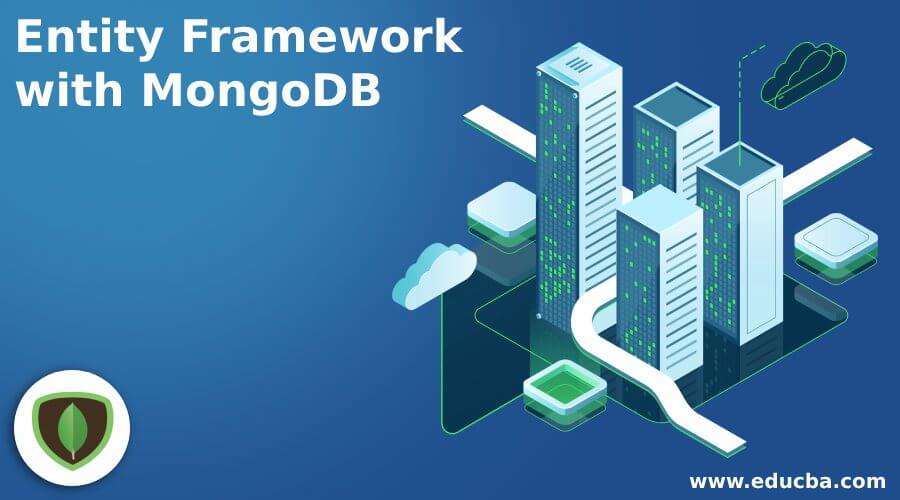Updated February 15, 2023
Introduction to Entity Framework with MongoDB
The entity Framework with MongoDB is endowed with the developers, the controller classes, and the entity for storing the entities completely in the collection of MongoDB. Therefore, it removes the requirement for the base table or SQL Queries like the Entity’s ID, properties, name, or any field data, which is entirely written directly on MongoDB.
Overview of Entity Framework with MongoDB
MongoDB is the wide-ranging and most accessible document database that completely fits for recent applications. The .NET Frameworks languages such as C# are evenly well-liked and resourceful. The developers can use two ways of technology along with MongoDB Atlas, an entirely handled and multi-cloud database service, to develop dominant applications quickly. Entity Framework is an Object Relation Mapper (ORM) mapping the objects in the application tire to the Relational Model in the Data-Tire. In MongoDB, with the assistance of Mongo driver Objects, it is directly accepted by the Data-Tire. So there is no need for the ORM (Object Relation Mapper). Using Entity Framework for MongoDB or building and providers is heavy-handedness.
MongoDB is the document database not supported by physical relations between the collections. The Entity Framework is the excellent approach that best fits for relational databases like SQL, MySQL, and so on. MongoDB works faster with embedded documents. So let’s understand that they represent two different approaches. Entity Framework Core has no official MongoDB in .NET Core Versions.
The MongoDB is used to develop on the Scale-Out architecture, which grows to be well-liked with the developers of whole developing applications scalable with evolving data schemas. The MongoDB as a Document Database makes it simple for the developers to accumulate structured or unstructured data.
Mongo Entity offers the developers Entity and Controller Classes to store the entities in the MongoDB Collection. It removes the requirement for the base table or SQL Queries like the Entity’s ID, properties, name, or any field data that is entirely written directly on MongoDB. Instead, MongoDB supports the classes for the embedded entities, those entities stored as the sub-documents in the collection parent, which can be dealt with using standard Entity API CURD functions and identified with EntityFieldQuery. Eventually, when loading the parent entity, be required to automate the load and entrench entire child entities with one query to a distinct MongoDB Collection. MongoDB is a wide-ranging all-purpose, flexible document database perfectly suitable for modern applications.
The Mongo Entity is for the developers, which provides no interface and does not modify the activities of the existing sites out of the box. However, the provided MongoEntity can use the modules, and the MongoEntityController Classes in the Hook_Entity_Info store the entities in the MongoDB than the SQL Database.
Features of MongoDB Entity Framework
Given below are the features mentioned:
- Embedding: It stores the child entities with their parent document for a more reasonable collection schema.
- Performance Boost: The field data is stored with the Entity in MongoDB, which decreases the requirement for the complex JOINs, and the various database queries to load the single object.
- Minimal Configuration: There is no need for SQL tables to store the custom Entity completely in automated MongoDB Collections.
Accessing Entity Framework with MongoDB
Access the MongoDB data using the Entity Framework Code-First approach, available at .NET 4.5 and above versions.
The Entity Framework is an ORM (Object Relational Mapping) framework that works with the data as objects. In Visual Studio, when we execute the ADO.NET Entity Data Model Wizard handles to generate the Entity Model, which is a Model-First-Approach, it reflects the disadvantages of any modification in the data source, so it is a risk to change. So here we move on with the Code-First approach to access the MongoDB data using the CData ADO.NET provider.
- Initially, Open Visual Studio, click on New – Project and create a new Windows Form Application with C#.
- Execute the “Install-Package EntityFramework” command in the Package Manager Console by selecting the menu View – Other Windows – Package Manager Console. Install the latest release of Entity Framework.
- Alter App.config files in the project to include the references of MongoDB Entity Framework- 6 and connect the connection string.
- In the connection, the path sets the necessary properties like server, user, password, and Database Connection properties to establish the connection to MongoDB. To use MongoDB Collections as the table, we can automate the schema discovery or write our schema definitions.
- The schemas are defined in the format of .rsd files, and also we can execute the free-form queries which are not tied to the schema.
Code:
<configuration>
<connectionStrings>
<add name="db_MongoDBContext" connectionString="Offline=False;Server=your_serverName;Port=port_no;Database=db_name;User=user_name;Password=your_password;
"providerName="System.Data.CData.MongoDB" />
</connectionStrings>
<entityFramework>
<providers>
<provider invariantName="System.Data.CData.MongoDB" type="System.Data.CData.MongoDB.MongoDBProviderServices, System.Data.CData.MongoDB.Entities.EF6" />
</providers>
<entityFramework>
</configuration>- Add the references to the System.Data.CData.MongoDB.Entities.EF6.dll located in the lib 4.0 SubFolder in the Installation Directory.
- Develop the project to ensure it is working correctly or it is ok to start the coding using Entity Framework.
- Add the new .cs file to the project and include classes in it. It will be your databse_Context and can be extended to the DbContext class. In the below example, the class is named as MongoDBContext.
Let’s see the code which overrides the on ModelCreating function to make the modifications as follows:
- In the ModelBuilder Conventions, remove the PluralizingTableNameConvention.
- In the MigrationHistory table, remove the request.
Example:
Code:
using System.Data.Entity;
using System.Data.Entity.Infrastructure;
using System.Data.Entity.ModelConfiguration.Conventions;
class EF_MongoDBContext : DbContext
{
public EF_MongoDBContext() { }
protected override void OnModelCreating(DbModelBuilder obj_modelBuilder)
{
// in the migration history table to remove requests
Database.SetInitializer<EF_MongoDBContext>(null);
// removing the plural names
obj_modelBuilder.Conventions.Remove<PluralizingTableNameConvention>();
}
}Conclusion
In this article, we have seen the Entity Framework with MongoDB; MongoDB is a general-purpose and flexible document database perfectly suitable for modern applications.
Recommended Articles
This is a guide to Entity Framework with MongoDB. Here we discuss the introduction, features, and accessing entity framework with MongoDB. You may also have a look at the following articles to learn more –


